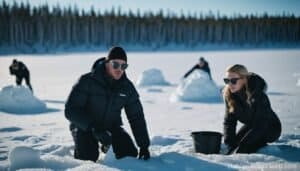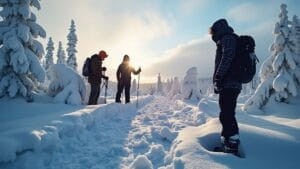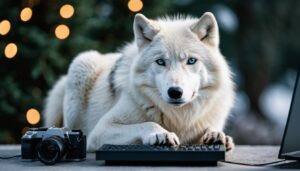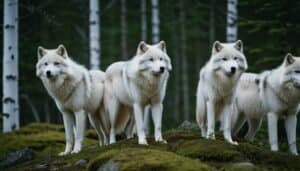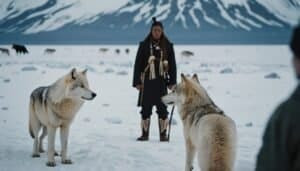Introduction
Arctic wolf conservation is a critical issue that requires comprehensive educational efforts to raise awareness and promote protection. This article explores various educational programs dedicated to Arctic wolf conservation, including those offered by organizations, schools, and online platforms
Additionally, it examines the role of community involvement, zoo initiatives, and international efforts in fostering a greater understanding and commitment to preserving these magnificent creatures
Key Educational Programs For Arctic Wolf Conservation
Educational programs dedicated to Arctic wolf conservation are essential in promoting awareness and fostering efforts to protect this species
These programs range from initiatives led by conservation organizations to school-based curricula and online courses. Each type of program plays a vital role in educating various audiences about the importance of Arctic wolf conservation
Overview Of Major Programs
Several major programs focus on Arctic wolf conservation, often led by renowned conservation organizations. These programs aim to educate the public about the challenges faced by Arctic wolves and the actions needed to protect them
For instance, the World Wildlife Fund (WWF) runs initiatives that include educational campaigns, workshops, and community engagement activities. These programs often feature interactive elements such as virtual reality experiences, which allow participants to immerse themselves in the Arctic wolf’s habitat, providing a deeper understanding of their environment and the threats they face
Another significant program is the Arctic Wolf Project by the Wildlife Conservation Society (WCS). This project not only involves field research but also incorporates educational components like public lectures, documentary screenings, and educational materials for schools
These initiatives aim to spread knowledge about Arctic wolves’ ecological roles and the importance of preserving their habitats
Programs Offered By Conservation Organizations
Conservation organizations play a pivotal role in Arctic wolf education. The International Wolf Center (IWC) offers a variety of programs, including the WolfLink videoconference program, which connects students and educators with wolf experts
This interactive experience allows participants to learn about wolf biology, behavior, and conservation efforts directly from professionals
Additionally, Defenders of Wildlife runs educational programs that focus on the broader aspects of wolf conservation, including the Arctic wolf. Their initiatives include community workshops, school visits, and public awareness campaigns. These programs are designed to reach diverse audiences and promote a comprehensive understanding of wolf conservation issues
School-Based Educational Programs
Educational institutions have integrated Arctic wolf conservation into their curricula to engage young minds in wildlife preservation. Many schools collaborate with conservation organizations to develop programs that fit into science and environmental studies courses
For example, the WWF’s Wild Classroom offers a range of resources, including lesson plans, activities, and videos tailored for different grade levels. These materials cover topics such as Arctic wolf ecology, the impact of climate change on their habitats, and conservation strategies
Programs like Project WILD provide educators with training and resources to incorporate wildlife conservation into their teaching. Through hands-on activities and interdisciplinary lessons, students gain a deeper appreciation for Arctic wolves and the need to protect their natural habitats
Online Courses And Resources
With the rise of digital learning, online courses and resources have become increasingly popular for spreading awareness about Arctic wolf conservation
Platforms like Coursera and edX offer courses on wildlife conservation, which often include modules on Arctic wolves. These courses are designed by leading universities and conservation organizations, providing participants with high-quality educational content
Websites such as National Geographic and the WWF also provide a wealth of online resources, including articles, videos, and interactive activities. These resources are accessible to a global audience, making it easier for individuals to learn about Arctic wolves and contribute to conservation efforts from anywhere in the world
Community And Zoo Involvement In Conservation
Community and zoo initiatives play a crucial role in Arctic wolf conservation efforts. These programs engage local communities and zoo visitors, providing them with educational experiences and opportunities to participate in conservation activities
By fostering a sense of stewardship and responsibility, these initiatives help build a broader support base for Arctic wolf conservation
Community Involvement And Participation
Community involvement is essential for successful conservation programs. Many organizations work directly with local communities to raise awareness about Arctic wolf conservation and involve them in hands-on activities
For example, the Arctic Wolf Conservation Cooperative (AWCC) runs community outreach programs that include educational workshops, conservation training sessions, and volunteer opportunities. These programs are designed to empower community members to take an active role in protecting Arctic wolves and their habitats
Additionally, local conservation groups often organize events such as nature walks, wildlife monitoring, and habitat restoration projects. These activities not only educate participants about Arctic wolves but also provide them with practical skills and knowledge to contribute to conservation efforts
Community-based programs help create a network of informed and motivated individuals who can advocate for Arctic wolf conservation within their own communities
Workshops And Seminars
Workshops and seminars are effective tools for disseminating knowledge about Arctic wolf conservation. Conservation organizations and academic institutions frequently host these events to share the latest research findings, conservation strategies, and best practices
For instance, the International Wolf Symposium, organized by the International Wolf Center, brings together scientists, conservationists, educators, and the public to discuss wolf conservation issues, including those affecting Arctic wolves
These events typically feature expert presentations, panel discussions, and interactive sessions, providing attendees with a comprehensive understanding of the challenges and opportunities in Arctic wolf conservation. Workshops and seminars also offer networking opportunities, allowing participants to connect with like-minded individuals and organizations committed to wildlife conservation
Zoo Initiatives For Arctic Wolf Awareness
Zoos play a significant role in educating the public about Arctic wolves and supporting conservation efforts
Many zoos have established dedicated Arctic wolf exhibits that provide visitors with an up-close look at these animals and their natural behaviors. These exhibits often include informational displays, educational programs, and live presentations by zookeepers and conservation experts
For example, the Minnesota Zoo’s “Northern Trail” exhibit features Arctic wolves and includes interpretive signs and interactive displays that educate visitors about the species’ biology, behavior, and conservation status. The zoo also offers educational programs such as keeper talks, school field trips, and summer camps that focus on Arctic wolf conservation
Zoos also participate in breeding programs and collaborative research projects aimed at enhancing the genetic diversity and health of captive Arctic wolf populations. These efforts contribute to the long-term survival of the species and provide valuable data for conservation initiatives in the wild
International Conservation Efforts
International conservation efforts are essential in the global quest to protect Arctic wolves
These programs often involve collaboration between multiple countries, organizations, and researchers, aiming to address the wide-ranging threats faced by Arctic wolves through comprehensive and coordinated strategies
International Conservation Programs
Several international programs focus on Arctic wolf conservation, leveraging resources and expertise from around the world
One notable example is the Arctic Biodiversity Assessment (ABA), coordinated by the Conservation of Arctic Flora and Fauna (CAFF) working group. This program involves extensive research and monitoring of Arctic biodiversity, including Arctic wolves, to inform conservation policies and practices. The ABA provides valuable data on the status and trends of Arctic wolf populations, helping guide international conservation efforts
Another significant initiative is the Arctic Council’s Arctic Monitoring and Assessment Programme (AMAP). AMAP conducts scientific assessments of pollution and climate change impacts on Arctic ecosystems, including those inhabited by Arctic wolves. By providing a scientific basis for policy-making, AMAP helps ensure that conservation measures are grounded in reliable data and address the most pressing threats to Arctic wolves
Effectiveness Of These Programs
Evaluating the effectiveness of international conservation programs is crucial for ensuring that resources are used efficiently and goals are met
Programs like the ABA and AMAP have been successful in raising awareness and generating valuable scientific data, but challenges remain. The vast and remote nature of the Arctic region makes monitoring and enforcement difficult, and geopolitical factors can complicate international collaboration
However, there have been notable successes. For example, collaborative research efforts have led to improved understanding of Arctic wolf ecology and the impacts of climate change on their habitats. These insights have informed conservation strategies, such as habitat protection and climate adaptation measures
Additionally, international agreements like the Convention on Biological Diversity (CBD) have facilitated cooperation and commitment among Arctic nations to protect wildlife, including Arctic wolves
Resources For Teaching About Arctic Wolf Conservation
A variety of resources are available to educators and conservationists seeking to teach about Arctic wolf conservation. International organizations often produce educational materials that can be used in classrooms and community programs
For instance, the World Wildlife Fund (WWF) and National Geographic offer comprehensive guides, videos, and interactive activities focused on Arctic wildlife conservation
The International Wolf Center provides extensive resources for educators, including lesson plans, activity guides, and multimedia presentations. These materials cover topics such as Arctic wolf behavior, habitat, and conservation challenges, making it easier for educators to incorporate Arctic wolf conservation into their curricula
Online platforms also offer valuable resources. Websites like Coursera and edX host courses on wildlife conservation that include modules on Arctic wolves, providing learners with access to expert knowledge and the latest research
These courses are often developed by leading universities and conservation organizations, ensuring high-quality content that can be used in various educational settings
Conclusion
Efforts to raise awareness about Arctic wolf conservation are diverse and multifaceted, involving key educational programs, community and zoo initiatives, and international conservation efforts. By examining these different approaches, we gain a comprehensive understanding of the strategies employed to protect these magnificent creatures and their habitats
Key educational programs, spearheaded by conservation organizations, schools, and online platforms, play a crucial role in spreading knowledge and fostering a conservation mindset
Community involvement and zoo initiatives further bolster these efforts by engaging the public through hands-on activities and educational experiences. International programs bring together global expertise and resources to address the wide-ranging threats facing Arctic wolves, ensuring that conservation measures are effective and far-reaching
Together, these efforts form a robust framework for Arctic wolf conservation, highlighting the importance of education, community engagement, and international collaboration in safeguarding the future of this iconic species
By continuing to support and expand these programs, we can contribute to the ongoing efforts to protect Arctic wolves and preserve the delicate balance of the Arctic ecosystem




